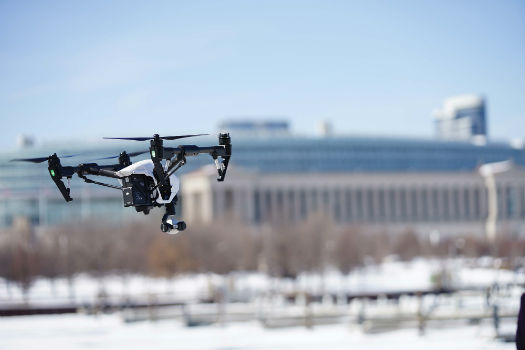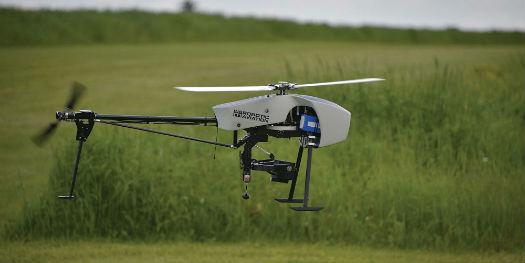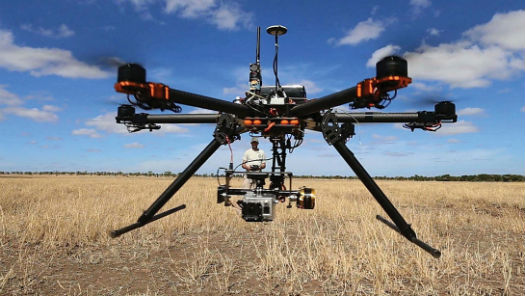
The FAA’s long-awaited notice of proposed rulemaking (NPRM) on the operation and certification of unmanned aircraft systems (UAS) outlines the regulator’s plan to integrate them into the U.S. National Airspace System. The FAA will begin by focusing on aircraft below 55 pounds (weight at takeoff).
On Feb. 23, the United States Federal Aviation Administration (FAA) published its long-awaited notice of proposed rulemaking (NPRM) on the operation and certification of small unmanned aircraft systems (sUAS) in the Federal Register. The posting set off sighs of relief in some quarters and handwringing elsewhere, as the 60-day countdown for public comment on the proposal began ticking away.
“We are happy to see the FAA seems to have followed the spirit of [our] advice in taking a thoughtful and measured approach,” National Press Photographers Association president Mark Dolan told Vertical. At the other end of the scale, one early commenter on the NPRM said one of its provisions “will cripple the viability of almost all known commercial applications of UAS technologies.”
To begin with, the NPRM seeks to provide, for the first time, an exact definition of a small UAS. Under current statutes, they are defined as remotely-piloted aircraft that weigh up to 55 pounds, but whether that refers to the weight of an empty aircraft or the total weight of the aircraft at the time of takeoff (the FAA’s suggested definition), is unclear.
The NPRM proposes that operators be allowed to fly sUAS up to 500 feet above ground level within their line of sight, up to a maximum airspeed of 87 knots (100 m.p.h.), and only during the daytime. Operations in Class B, C, D and E airspace would only be allowed with air traffic control (ATC) permission. (Clearance for Class E operations would only be required for tower-controlled airports.)

Former Navy helicopter pilot and San Diego Gas & Electric unmanned aircraft operator Teena Deering holds a drone as it is prepared for takeoff near Boulevard, Calif. Gregory Bull Photo
It states that the operator must have passed an aeronautical knowledge test focused on UAS regulations, classification of airspace, obstacle clearance, the effects of localized weather on sUAS, how to respond to emergencies during operation, and aeronautical decision making and judgment. After passing the test, getting screened by the Transportation Security Administration, and confirming his or her identity to the FAA or a certified flight instructor, an individual would be entitled to an “unmanned aircraft operator certificate”— a new category of airman certificate. No traditional pilot’s certificate would be required, nor would a separate observer have to be present. To maintain certification, the operator would have to pass the knowledge test every 24 months.
The NPRM proposes the introduction of a part 107 to Title 14 of the Code of Federal Regulations, tailored to address the risks associated with sUAS operations. The proposed part 107 would replace the airworthiness provisions of part 21, the airman certification provisions of part 61, and the operating limitations of part 91.
The 47-page NPRM contains extensive analysis of alternative regulatory approaches and explanations of the approach the FAA chose. It stresses the need for a risk-based approach to regulation, noting that with sUAS operations, the risk considerations are different to those of manned aircraft.
On the one hand, the NPRM states, sUAS “have the potential to pose significantly less risk to persons and property than comparable operations of a manned aircraft” that weigh between 1,300 and 6,000 pounds.

Waterloo, Ont.-based Aeryon Systems is one of many companies that have been established in recent years with a sole focus on producing small unmanned aircraft systems (sUAS). This SkyRanger is one of the company’s newest products. Mike Reyno Photo
On the other hand, it highlighted two risk concerns that are unique to sUAS: how to maintain a “see and avoid” capability during operation, and the potential for “loss of positive control” if the control link between the operator and the sUAS fails. The requirement for daylight line-of-sight operations seeks to address the first concern, while the concept of a “confined area of operation,” the speed restriction, and the proposal to prohibit operation over someone not directly involved in the operation of the aircraft have been created to mitigate the danger resulting from possible loss of control.
The FAA rejected the imposition of design standards and airworthiness certification for sUAS; it said such a process could take three to five years, and given the current pace of innovation, a model would likely be technologically outdated by the time it was certified.
The NPRM reiterates the FAA’s incremental approach to integrating drones into the National Airspace System (NAS). “Once the entire integration process is complete, the FAA envisions the NAS populated with UAS that operate well beyond the operational limits proposed in this rule,” the NPRM states. “Those UAS will be regulated differently than the UAS that would be integrated through this rule, and will be addressed in subsequent rulemakings. The FAA has selected this approach because it would allow lower-risk small UAS operations to be incorporated into the NAS immediately instead of waiting until the issues associated with higher-risk UAS operations are resolved.”
In the press briefing announcing the NPRM, FAA Administrator Michael Huerta stressed that the NPRM was still just a proposal — and until a final rule is published, the current regulations banning commercial sUAS flight without a waiver or exemption continue to apply.

The NPRM proposes that operators be allowed to fly sUAS up to 500 feet above ground level within their line of sight, up to a maximum airspeed of 87 knots (100 m.p.h.), and only during the daytime.
Industry Reponse
“So far,” a senior FAA official said, a week after the NPRM release, “the reaction has been favorable. But we have only heard from the UAS industry so far.”
The interesting question is whether, as Helicopter Association International president Matt Zuccaro forecast in a recent editorial in Vertical (see p.8, Feb-Mar 2015), helicopter operators will eventually become the largest operators of sUAS aircraft. “Who better to operate vertical lift UAVs in a low altitude environment — conducting missions they already perform — than helicopter operators?” wrote Zuccaro.
The interest from the traditional customers of helicopter operators is clear — those involved in industries ranging from agriculture to electric utilities, and from aerial photography to film and television production have registered their desire to incorporate sUAS in their operations.
“This has been a long time coming; it can’t get here soon enough,” Frankie Hall, of the Florida Farm Bureau Federation, told Vertical. “It is a major new tool to increase agricultural productivity further.”
Mike Cavender, executive director of the Radio Television Digital News Association, said, “The level of interest … in the journalism community is huge; this has been one of the biggest areas of interest for the last year or so.” Indeed, the upcoming National Association of Broadcasters Show is set to feature an entire pavilion dedicated to drones and robotics, with dozens of presentations on how to use sUAS for newsgathering.

ING Robotic Aviation supplied UAS to the Canadian military in Afghanistan, but the Ottawa, Ont.-based company sees agricultural operations as a key sector for future growth.
Some helicopter operators are embracing the opportunity. Helinet Aviation Services, based in Van Nuys, Calif., has been providing rotary-wing transportation for over 25 years in the motion picture, television-production, news, and emergency medical services industries. It recently applied for — and received — a section 333 exemption to add sUAS to its fleet for operation on movie sets. The company plans to use Gryphon Dynamics X8 and DJI S1000 octocopters. In its application for the exemption, Helinet pointed to the safety benefits of using a small UAS for film operations compared to “aircraft that weigh around 4,000 pounds, and which carry large amounts of Jet A fuel.”
But others aren’t so keen. “No!” said Randy Mank, owner of Heli-Photo in Baltimore, Md., when asked if he would add drone services. “We’re strictly a helicopter company. I’m into flying — I’d be surprised by any pilot who didn’t say the same thing.” He is resigned, however, to the phenomenon: “It doesn’t matter what the FAA says; it’s just a matter of time before there are a million of them.”
Sibylle Allgaier, owner of Heliphoto in Los Angeles, Calif., is probably typical of most helicopter operators. “I have a love-hate relationship with drones,” she said. “I started putting a drone together, practiced flying it and practiced taking video. If a client wants drone shots, I’ll offer it. I will advertise drone services once it becomes legal. We’ll see how things develop. But I’ll always prefer to be in a helicopter.”
Allgaier believes sUAS will inevitably cut into the market for helicopter photography — particularly for real estate. “It will depend on the pricing, [but] there also will be some things clients want that you can’t do with a helicopter,” she said. “In 10 years, the bigger ones with ADS-B will make everything more complicated. Aerial photography in helicopters will be obsolete. It will all be drones.”

How the FAA intends to regulate larger UAS, such as this DP-14 Hawk from Dragonfly Pictures, Inc., is still to be decided. The DP-14 is designed to carry 430 pounds of useful payload. Mike Reyno Photo
Pilots Still Required
From the customer’s perspective, however, the growing use of sUAS is not going to wipe out the need for manned helicopters. “The impact on ENG helicopters is going to be modest,” said Cavender. “The day the rule becomes final is not going to be the day that all the helicopter pilots are unemployed. The stations that use helicopters will continue to use them, although they may use them differently.” He added that it isn’t just the stations in big markets that use helicopters. “In some areas, geography requires them, not just to capture aerial imagery, but for transportation of ground teams. Of course, now smaller stations that don’t use helicopters have another way to get aerial coverage.”
Moreover, some helicopter markets are impervious to competition from UAS for the foreseeable future because they involve passengers: emergency medical services, offshore oil-and-gas transportation, executive charters, aerial tourism, and heavy lift.
“Drones are just a new tool,” said professional photographer Curt Waltz, owner of Aerialscapes, based in Hartland, Wis. “If one can do something a helicopter can’t [or] can do it better and cheaper, why not?“ He is skeptical, however, about the line-of-sight restriction in an urban environment. He also worries about economics.

If the NPRM is approved in its current version, sUAS operators would have to possess an “unmanned aircraft operator certificate”— a new category of airman certificate. To gain this, they will need to pass an aeronautical knowledge test focused on sUAS operations.
“If you’re a kid and doing it for fun, $400 for an assignment is great,” he said. “But how many $400 assignments do you have to have to support a family? And you have to drive to the different locations. Last week, on one helicopter flight, I did 11 assignments. I was done in two hours.”
Much remains to be learned, about the content of the final rule (or rules), as well as the economics and the technologies. The FAA will be accepting comments on the NPRM until April 24, 2015, and it has specifically invited comment on whether it should adopt the approach recommended by the UAV America Fund, with different rules for different weight classes (up to the maximum of 55 pounds). It asks whether specific technologies should be prescribed for dealing with lost control links and whether sUAS operators should take practical tests as well as a knowledge test. As Allgaier argues, “Part of the test should be flying and shooting, and actually creating videos. Prove to the inspector that you can do both and maintain altitude.”
The use of sUAS and how to incorporate them into the National Airspace System is clearly a divisive issue. Once the window for comments on the NPRM closes, the FAA is going to face a major challenge to draw them together into a final rule that can survive judicial review. One thing is certain, though — we better get used to the presence of sUAS in our skies.





